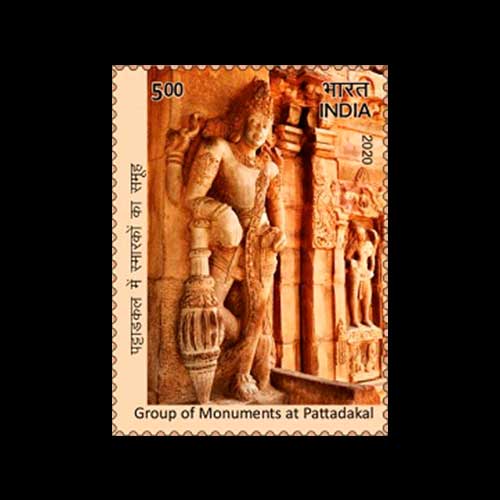Fascinating Archaeological Facts on Postage Stamps - 87
2025-08-14 Thu
Pattadakal is a complex of Hindu and Jain temples dati incredb to the 7th and 8th centuries CE, located in Bijapur, Karnataka. The city was previously known as Pattada Kisuvolal, which translates to "City of Crown Rubies." Rekha Rao, in her work ‘A Journey of Rocks: From the Hills to Temples of Karnataka (2021)’, notes that this site was used during the Chalukya dynasty for coronation ceremonies, including that of Vinayaditya in the 7th century CE. Other historical names for this location include Kisuvolal, translating to "valley of red soil," and Raktapura, which means "city of red." It is noteworthy that Pattadakal also features a considerable number of megalithic monuments.Situated along the Malaprabha River, the complex consists of ten principal temples—nine of which are dedicated to LORDSHIVA and one to Jainism—clustered together alongside numerous smaller shrines. Designated as a UNESCO world heritage Site, the monuments at Pattadakal exhibit a remarkable blend of architectural styles, including Rekha Nagara Prasada Shikhara and Dravida Vimana. Most of the temples feature a garbha griha that connects to an antarala, which in turn leads to a pillared mandapam. Rising above the sanctum is a shikhara, crowned with a kalash.
As per the archaeological Survey of India (ASI), the Sangamesvara Temple, erected by Vijayaditya Satyasraya between 697 CE and 733 CE, is the oldest temple within the complex. The Galaganatha Temple, constructed in the 8th century CE, exemplifies the rekha nagara prasada architectural style. This particular style is characterized by a square-based shikhara with walls that curve inward to a point at the top. The last temple built in the early Chalukyan style is the Kasivisvesvara Temple. The most recent addition to the site was a Jain temple known as Jaina Narayana, commissioned during the reign of Rashtrakuta ruler Krishna II in the 9th century CE, dedicated to Parsvanatha, the 23rd Jain Tirthankar.
Among the temples at Pattadakal, the Virupaksha Temple stands out as the most magnificent, constructed around 740 CE. This temple was commissioned by Queen Lokamahadevi to commemorate her husband, King Vikramaditya II's victory over Kanchi, the capital of the Pallava #dynasty. The temple is distinguished by its inscriptions of the artists' names located beneath the panels they adorned. Other notable temples within the complex include the Kadasiddheshwara, Jambulingeshwara, Chandrashekhara, Trillokeshwara, and Papanatha temples.
Additionally, excavations at Pattadakal, as written by Aditi Shah in Peepul Tree Stories, have uncovered early historical artifacts, including rectangular houses, copper coins (both with and without inscriptions), semi-precious Stone beads, shell bangles, burnt clay figurines, iron tools, and Silver punch-marked coins, among other significant findings.
On 15 August 2020, India post issued a set of five stamps along with a #miniature sheet entitled "UNESCO World Heritage Sites in India - Cultural Sites." Among these stamps is one featuring the Group Monuments of Pattadakal, issued with a face value of ?5.
Latest News
-
Ghiyath Shah as Heir Apparent
2025-09-25 ThuGhiyath Shah was the ruler of the Malwa Sultanate, reigning from 1456 to 1500. From 1456 to 1469, he...
-
Malwa Sultan Mahmud Shah Silver Coins
2025-09-11 ThuMalwa Sultan Mahmud Shah minted silver coins in round and square flans. <br><br> For round coins,...
-
Malwa Sultan Mahmud Shah Billon coin
2025-08-26 TueMalwa Sultan Mahmud Shah's billon coins followed three weight standards: 100 rati, 96 rati, and 80 r...
-
Fascinating Archaeological Facts on Postage Stamps - 91
2025-08-23 SatRhinoceros is one of the oldest land mammal species existing in India. There are five species of rhi...
-
Fascinating Archaeological Facts on Postage Stamps - 90
2025-08-23 SatUthiramerur, a Village in Kanchipuram, Tamil Nadu, is notable for its Temple inscriptions that descr...

